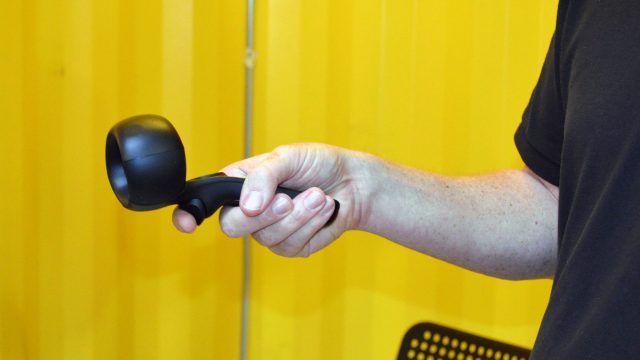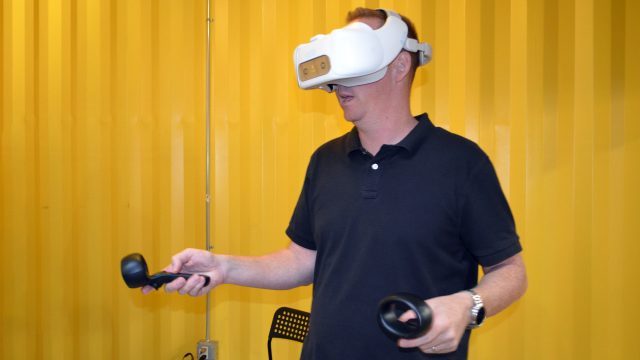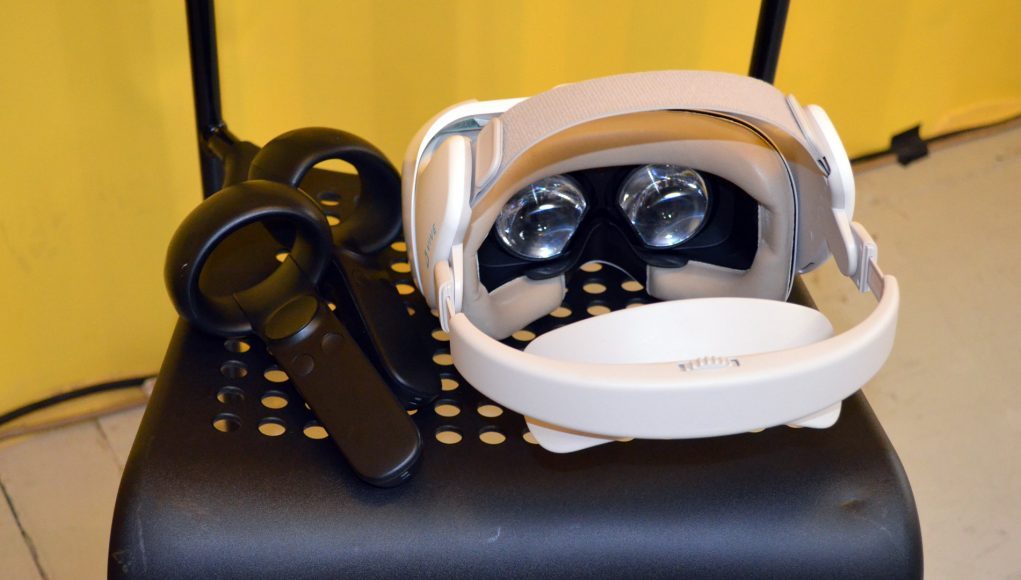While the Vive Focus initially launched with a single 3DOF controller, HTC recently announced a dev kit add-on which brings a pair of 6DOF controllers to the standalone headset. We got our first chance to try out the system today at an HTC press event in San Francisco.
The 6DOF controller add-on is comprised of a pair of new controllers and a shell attachment which connects to the front of the Focus headset. The shell includes necessary hardware for the tracking system which is based on ultrasonics. Ultrasonic tracking uses soundwaves at frequencies above the audible human range for triangulation, typically using a series of receivers to identify differences in timing between ultrasonic sounds emitted by the tracked object. We don’t have confirmation from HTC at this point, but there’s strong hints that system is based on ultrasonic technology by Chirp Microsystems.
The tiny holes seen on the controllers and the headset shell are the points where ultrasonic sound waves are emitted or received (it’s unclear at this point which functions as the emitter and which is the receiver, though I’d guess the controllers are the emitters).
Today at a press event in San Francisco we got our first chance to try out the 6DOF controller dev kit.

The controllers themselves have a large bulbous portion up top (covered in holes for tracking), but were remarkably light regardless. Each controller has a trackpad, trigger, bumper (an awkwardly placed second trigger on the back), and two buttons below the trackpad. Considering the poor bumper usability, hopefully the controller form factor will evolve before it leaves dev kit status. The shell that attaches to the front of the Focus seems to add notable extra weight, putting more pressure on your face than without it.
Unfortunately the quite noisy demo environment wasn’t the ideal place to test the performance of the system, as the chaotic sonic environment may impact the tracking, and the performance I saw today might not represent best-case performance. That said, HTC offered no such caveats for the system or the demo setup when handing over the headset and controllers for a demo, which was all about their Vive Sync collaborative VR space.
After strapping on the headset and picking up the controllers, I saw my virtual hands floating in front of me. My hands responded with full 6DOF movement as I moved them around, but it was quickly noticeable that the positional latency is not at the same bar as leading controller tracking systems like those used with the Vive or Rift, or even Windows VR or PSVR.
That said, latency in hand tracking is not as critical as with head tracking, so ‘good enough’ can in fact be good enough for casual input use-cases. Whether or not the system would be tight enough for something like Beat Saber is still up in the air.
Accuracy (how close the virtual position of the controller is to its actual actual position) seemed good. Unlike 3DOF controllers, which can get out of whack after a lot of movement and need regular recalibration, the 6DOF Focus controllers were always where I expected them to be, and made it easy enough to do simple tasks like like making a selection on a menu or drawing in 3D in the air.
Precision (how much movement there is even when the controller is perfectly still, AKA jitter) was noticeably not at the ‘sub-mm’ bar set by high-end tracking systems. In practice that means when holding the controller still you can see it shake around a bit as it continuously evaluates its location with some degree of error. Again, probably fine for casual input, but if you’re doing a task which requires small, high precision movements, it could be a frustrating experience.

I didn’t get a good chance to test the size of the tracking volume in relation to the headset; ultrasonic requires line of sight like most standalone 6DOF controller systems, which means if you put your controllers behind your back they’re likely to get lost by the system and fall back to IMU estimation until being brought back into the tracking volume.
We’ll need to spend more time testing the 6DOF Focus controller dev kit to better feel out their performance, and understand where that performance becomes a limiting factor for certain use-cases, but at this early stage, it feels like it should work fine for most casual input cases.
Considering that HTC is now positioning the Vive Focus as a professional/enterprise focused product, there’s probably many ‘casual input’ cases where the current performance will be good enough. For some use-cases though, like creating 3D models or making precise changes to design-focused content, users might opt for something more accurate and precise.
And finally, I’ll head off this question now because it’ll definitely crop up in the comments below: From my (limited) testing so far, Quest’s optical controller tracking is currently setting the bar for 6DOF standalone headsets, and seems significantly further ahead across all performance factors (latency, accuracy, and precision) compared to the Focus 6DOF controller dev kit. I’m doubtful that an ideal demo environment would make a substantial difference, but hopefully I’ll have a chance to test it in such a setting soon.










